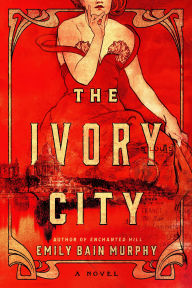A Frisson of Magic: A Guest Post by Emily Bain Murphy
This is a gripping murder mystery — with a delightful dash of romance — that will keep you glued to the page. Read on for an exclusive essay from author Emily Bain Murphy on writing The Ivory City and setting her novel during the 1904 St. Louis World’s Fair.
The Ivory City: A Novel
The Ivory City: A Novel
In Stock Online
Paperback
$14.24
$18.99
The Devil in the White City meets Pride and Prejudice in this romantic historical murder mystery set at the 1904 World’s Fair.
The Devil in the White City meets Pride and Prejudice in this romantic historical murder mystery set at the 1904 World’s Fair.
I happened to visit the 1904 St. Louis World’s Fair exhibit at the Missouri History Museum on the final day before it shut down for a multi-year renovation. An acquaintance had casually mentioned that the long-time exhibit was closing and I felt that frisson of magic, that sense that a story might be waiting there. As I wandered through the exhibit, the plot for a murder mystery came to me perhaps more quickly than any of my books ever have.
I scribbled down some ideas and plunged into research, from visiting an old mansion with an attic full of Fair memorabilia to meeting with historians and taking a walking tour of what used to be the Philippine Village. Along the way I learned that almost 20 million people poured through the gates of the 1904 World’s Fair and changed the world forever.
I loved imagining what it must have been like to visit the largest and most expensive World’s Fair yet, set amidst the lush grounds of St. Louis’s Forest Park. The air would have been perfumed with sugar from new inventions like the cotton candy machine and relatively new foods, like the ice cream cone, iced tea, Jell-o, and Dr Pepper. Puffed rice (the precursor to Rice Krispies and Cheetos) was shot out of a cannon. Elephants slid down slides, and people were wed inside—and even on top of—a massive Ferris wheel.
“The Ivory City,” as the Fair was called, was made up of fifteen hundred pavilions and palaces that held gleaming personal automobiles, airships, and x-ray machines. Fairgoers wove through displays from over 60 countries, getting a taste of the world’s diverse architecture, food, and culture. For the first time ever, wireless messages could be sent to Chicago without a telegraph line, and electricity illuminated the Fair with the help of Thomas Edison himself. Exhibits displayed brand-new inventions like bread machines and coffee makers, an early version of a fax machine, and the electric typewriter—as well as a sculpture of President Roosevelt made entirely out of butter.
It was a gorgeous, exhilarating seven months that made world history. But the Fair, for all of its progress and promise, was not without its horrors. Baby incubators showed off premature infants in squalid conditions where many of them died without proper care. The Philippine Village, one of the Fair’s most publicized attractions, is viewed in retrospect as possibly its greatest shame. Filipino tribes were ranked in order of their “civilization” and showcased as “anthropologic zoos” with little dignity. Several people died due to disease, poor treatment, and suicide.
The 1904 World’s Fair put the best and worst parts of our humanity on display: thrilling progress, shared culture, technological advancements, mistreatment, cruelty, and boundless imagination. I tried to capture its beauty and complexity in the murder mystery and romance that became THE IVORY CITY, an ode a shimmering moment in time when people streamed by the millions through St. Louis’s gates to make history—and left carrying a glimpse of the future alongside their souvenirs of ruby red flash glass.

